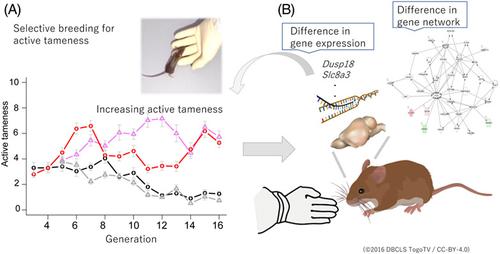当前位置:
X-MOL 学术
›
Genes Brain Behav.
›
论文详情
Our official English website, www.x-mol.net, welcomes your
feedback! (Note: you will need to create a separate account there.)
Combined change of behavioral traits for domestication and gene‐networks in mice selectively bred for active tameness
Genes, Brain and Behavior ( IF 2.4 ) Pub Date : 2020-12-13 , DOI: 10.1111/gbb.12721 Yuki Matsumoto 1, 2, 3 , Hiromichi Nagayama 1, 2 , Hirofumi Nakaoka 2, 4 , Atsushi Toyoda 5 , Tatsuhiko Goto 1, 6 , Tsuyoshi Koide 1, 2
Genes, Brain and Behavior ( IF 2.4 ) Pub Date : 2020-12-13 , DOI: 10.1111/gbb.12721 Yuki Matsumoto 1, 2, 3 , Hiromichi Nagayama 1, 2 , Hirofumi Nakaoka 2, 4 , Atsushi Toyoda 5 , Tatsuhiko Goto 1, 6 , Tsuyoshi Koide 1, 2
Affiliation

|
Tameness is a major element of animal domestication and involves two components: motivation to approach humans (active tameness) and reluctance to avoid humans (passive tameness). To understand the behavioral and genetic mechanisms of active tameness in mice, we had previously conducted selective breeding for long durations of contact and heading toward human hands in an active tameness test using a wild‐derived heterogeneous stock. Although the study showed a significant increase in contacting and heading with the 12th generation of breeding, the effect on other behavioral indices related to tameness and change of gene expression levels underlying selective breeding was unclear. Here, we analyzed nine tameness‐related traits at a later stage of selective breeding and analyzed how gene expression levels were changed by the selective breeding. We found that five traits, including contacting and heading, showed behavioral change in the selective groups comparing to the control through the generations. Furthermore, we conducted cluster analyses to evaluate the relationships among the nine traits and found that contacting and heading combined in an independent cluster in the selected groups, but not in the control groups. RNA‐Seq of hippocampal tissue revealed differential expression of 136 genes between the selection and control groups, while the pathway analysis identified the networks associated with these genes. These results suggest that active tameness was hidden in the control groups but became apparent in the selected populations by selective breeding, potentially driven by changes in gene expression networks.
中文翻译:

选择性饲养以主动驯服的小鼠驯化行为特征和基因网络的组合变化
驯服是动物驯化的一个主要因素,包括两个部分:接近人类的动机(主动驯服)和不愿避开人类(被动驯服)。为了了解小鼠主动驯服的行为和遗传机制,我们之前使用野生来源的异种种群在主动驯服测试中进行了长时间接触和走向人类手的选择性育种。尽管该研究显示与第 12 代育种的接触和前进显着增加,但对其他与驯服相关的行为指标和选择性育种基因表达水平变化的影响尚不清楚。在这里,我们分析了选育后期与驯服相关的九个性状,并分析了选育如何改变基因表达水平。我们发现,与对照组相比,选择组的五个特征,包括接触和前进,在几代人中表现出行为变化。此外,我们进行了聚类分析以评估九个特征之间的关系,发现在选定的组中接触和方向结合在一个独立的聚类中,但在对照组中没有。海马组织的 RNA-Seq 揭示了选择组和对照组之间 136 个基因的差异表达,而通路分析确定了与这些基因相关的网络。这些结果表明,主动驯服隐藏在对照组中,但通过选择性育种在选定的种群中变得明显,这可能是由基因表达网络的变化驱动的。与几代人的对照相比,显示出选择性组的行为变化。此外,我们进行了聚类分析以评估九个特征之间的关系,发现在选定的组中接触和方向结合在一个独立的聚类中,但在对照组中没有。海马组织的 RNA-Seq 揭示了选择组和对照组之间 136 个基因的差异表达,而通路分析确定了与这些基因相关的网络。这些结果表明,主动驯服隐藏在对照组中,但通过选择性育种在选定的种群中变得明显,这可能是由基因表达网络的变化驱动的。与几代人的对照相比,显示出选择性组的行为变化。此外,我们进行了聚类分析以评估九个特征之间的关系,发现在选定的组中接触和方向结合在一个独立的聚类中,但在对照组中没有。海马组织的 RNA-Seq 揭示了选择组和对照组之间 136 个基因的差异表达,而通路分析确定了与这些基因相关的网络。这些结果表明,主动驯服隐藏在对照组中,但通过选择性育种在选定的种群中变得明显,这可能是由基因表达网络的变化驱动的。我们进行了聚类分析以评估九个特征之间的关系,发现在选定的组中接触和方向结合在一个独立的聚类中,但在对照组中没有。海马组织的 RNA-Seq 揭示了选择组和对照组之间 136 个基因的差异表达,而通路分析确定了与这些基因相关的网络。这些结果表明,主动驯服隐藏在对照组中,但通过选择性育种在选定的种群中变得明显,这可能是由基因表达网络的变化驱动的。我们进行了聚类分析以评估九个特征之间的关系,发现在选定的组中接触和方向结合在一个独立的聚类中,但在对照组中没有。海马组织的 RNA-Seq 揭示了选择组和对照组之间 136 个基因的差异表达,而通路分析确定了与这些基因相关的网络。这些结果表明,主动驯服隐藏在对照组中,但通过选择性育种在选定的种群中变得明显,这可能是由基因表达网络的变化驱动的。海马组织的 RNA-Seq 揭示了选择组和对照组之间 136 个基因的差异表达,而通路分析确定了与这些基因相关的网络。这些结果表明,主动驯服隐藏在对照组中,但通过选择性育种在选定的种群中变得明显,这可能是由基因表达网络的变化驱动的。海马组织的 RNA-Seq 揭示了选择组和对照组之间 136 个基因的差异表达,而通路分析确定了与这些基因相关的网络。这些结果表明,主动驯服隐藏在对照组中,但通过选择性育种在选定的种群中变得明显,这可能是由基因表达网络的变化驱动的。
更新日期:2020-12-13
中文翻译:

选择性饲养以主动驯服的小鼠驯化行为特征和基因网络的组合变化
驯服是动物驯化的一个主要因素,包括两个部分:接近人类的动机(主动驯服)和不愿避开人类(被动驯服)。为了了解小鼠主动驯服的行为和遗传机制,我们之前使用野生来源的异种种群在主动驯服测试中进行了长时间接触和走向人类手的选择性育种。尽管该研究显示与第 12 代育种的接触和前进显着增加,但对其他与驯服相关的行为指标和选择性育种基因表达水平变化的影响尚不清楚。在这里,我们分析了选育后期与驯服相关的九个性状,并分析了选育如何改变基因表达水平。我们发现,与对照组相比,选择组的五个特征,包括接触和前进,在几代人中表现出行为变化。此外,我们进行了聚类分析以评估九个特征之间的关系,发现在选定的组中接触和方向结合在一个独立的聚类中,但在对照组中没有。海马组织的 RNA-Seq 揭示了选择组和对照组之间 136 个基因的差异表达,而通路分析确定了与这些基因相关的网络。这些结果表明,主动驯服隐藏在对照组中,但通过选择性育种在选定的种群中变得明显,这可能是由基因表达网络的变化驱动的。与几代人的对照相比,显示出选择性组的行为变化。此外,我们进行了聚类分析以评估九个特征之间的关系,发现在选定的组中接触和方向结合在一个独立的聚类中,但在对照组中没有。海马组织的 RNA-Seq 揭示了选择组和对照组之间 136 个基因的差异表达,而通路分析确定了与这些基因相关的网络。这些结果表明,主动驯服隐藏在对照组中,但通过选择性育种在选定的种群中变得明显,这可能是由基因表达网络的变化驱动的。与几代人的对照相比,显示出选择性组的行为变化。此外,我们进行了聚类分析以评估九个特征之间的关系,发现在选定的组中接触和方向结合在一个独立的聚类中,但在对照组中没有。海马组织的 RNA-Seq 揭示了选择组和对照组之间 136 个基因的差异表达,而通路分析确定了与这些基因相关的网络。这些结果表明,主动驯服隐藏在对照组中,但通过选择性育种在选定的种群中变得明显,这可能是由基因表达网络的变化驱动的。我们进行了聚类分析以评估九个特征之间的关系,发现在选定的组中接触和方向结合在一个独立的聚类中,但在对照组中没有。海马组织的 RNA-Seq 揭示了选择组和对照组之间 136 个基因的差异表达,而通路分析确定了与这些基因相关的网络。这些结果表明,主动驯服隐藏在对照组中,但通过选择性育种在选定的种群中变得明显,这可能是由基因表达网络的变化驱动的。我们进行了聚类分析以评估九个特征之间的关系,发现在选定的组中接触和方向结合在一个独立的聚类中,但在对照组中没有。海马组织的 RNA-Seq 揭示了选择组和对照组之间 136 个基因的差异表达,而通路分析确定了与这些基因相关的网络。这些结果表明,主动驯服隐藏在对照组中,但通过选择性育种在选定的种群中变得明显,这可能是由基因表达网络的变化驱动的。海马组织的 RNA-Seq 揭示了选择组和对照组之间 136 个基因的差异表达,而通路分析确定了与这些基因相关的网络。这些结果表明,主动驯服隐藏在对照组中,但通过选择性育种在选定的种群中变得明显,这可能是由基因表达网络的变化驱动的。海马组织的 RNA-Seq 揭示了选择组和对照组之间 136 个基因的差异表达,而通路分析确定了与这些基因相关的网络。这些结果表明,主动驯服隐藏在对照组中,但通过选择性育种在选定的种群中变得明显,这可能是由基因表达网络的变化驱动的。











































 京公网安备 11010802027423号
京公网安备 11010802027423号